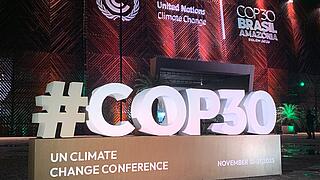It’s all about CO2 – or not quite?

© plainpicture / Martin Sigmund
In the case of our belching cow it is methane, while the air-conditioning unit will often contain dichlorodifluoromethane (R12), commonly known as Freon-12, a member of the group of chlorofluorocarbons (CFCs). Both substances have a major climate impact, partly because their global warming potential (GWP) per unit substance is much greater than that of CO2. Methane’s GWP is some 25 times greater, and that of R12 is more than 10,000 times greater. This is why these two non-CO2 gases accounted for a good 16 percent (methane) and almost 8 percent (R12) of global warming in 2021. The contribution of CO2 in that year was around 66 percent.
Climate action that fails to focus on such non-CO2 gases will not be effective. Tim Brown is keen to stress this. The mission of his Tradewater company is to prevent these substances from being released to the atmosphere. “We’ll miss the Paris Agreement targets if we lose sight of these substances,” the Tradewater CEO says.
What exactly are we talking about?
The array of non-CO2 gases that drive global warming is broad. One is nitrous oxide, with a global warming potential 265 times that of CO2, coming mainly from nitrogen fertilisers used in agriculture. Non-CO2 gases also include fluorinated greenhouse gases, known as F-gases, with a global warming potential up to 23,500 times that of CO2.
Ozone-depleting substances such as CFCs were long used as refrigerants. Their use in new products is banned since 1995. This ban followed the adoption of the Montreal Protocol on Substances that Deplete the Ozone Layer, which heralded the global phase-out of CFCs. Nonetheless, refrigerators containing CFCs are still to be found in many households. In order that those substances don’t enter the atmosphere, the appliances need to be disposed of in a carefully managed process. “For one thing, CFCs have a very large climate impact. For another, it is impossible to recapture them once released – in marked contrast to CO2,” Tim Brown explains. “Yet very few know about this and awareness of its importance is very low. The situation is much the same in U.S. politics, where the focus is largely on removing CO2 from the atmosphere.”
How to prevent release?
The way forward: to collect and properly destroy the potent ozone depleting substances, contained in refrigerators and air-conditioners.

Tradewater has already delivered numerous projects of this kind. But we’re also tackling the old CFC stockpiles that are still to be found around the world and can no longer be used today.
It all started in the USA. Today the company operates in numerous countries, with staff in Thailand, India and South Africa, to name a few.
For ozone-depleting substances to be destroyed properly, they first have to be brought to facilities meeting strict standards. Here they are burnt in rotary kilns. “The kiln’s shell is lined with a refractory material allowing temperatures up to 1300 degrees Celsius. There will usually also be downstream furnaces ensuring that the hazardous substances are destroyed fully.”
What is more, Tradewater is also working to prevent uncontrolled methane release from abandoned coal mines or orphaned oil and gas wells. Overall, the company has developed more than 70 projects around the globe.
Who finances this?
Anyone purchasing a carbon credit to offset their emissions is free to opt for credits generated by a project that focuses on non-CO2 gases. “We can only finance our work via the carbon market, as no regulatory authority or any other institution issues commissions to destroy these substances.” In January 2024, Tradewater sold the last carbon offset credit for the destruction of a large CFC importer stockpile found in Honduras. “Overall, the market share of projects focussing on non-CO2 gases is not overly large. It averaged 11 percent over the past five years. This is doubtlessly because they are often much smaller and generally far more complex than afforestation projects, for instance. “On the other hand, though, we offer exceptionally high quality in the offset market. For our projects are always additional and permanent, and the quantities of greenhouse gases destroyed are measured,” Tim Brown explains.
When a cow belches once it naturally won’t have much of an effect upon total emissions. But it remains important, indeed essential, to keep the entirety of non-CO2 emissions in view, while continuing to focus on CO2 as well.
As early as 2008, Tim Brown founded Wabashco, a company producing carbon offset credits – with a focus on renewable energy sources at the time. In 2016, he and a partner founded Tradewater, headquartered in Chicago, USA. Today he is Tradewater’s CEO. The company is dedicated to finding and destroying non-CO2 gases, financing this work through the carbon offset market. To date, more than 70 projects have been carried out around the world. Tradewater states that the greenhouse gases destroyed by these projects amount to 7.5 million tons of carbon dioxide equivalent.
Further information
Topic page on the German Environment Ministry website: Fluorinated greenhouse gases (F-gases)
Validation and Verification Report: ACR799 Tradewater International Honduras 1.0
Portrait Tim Brown © Jill Riddell



